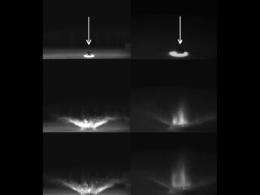Scientists detected surprising gases in Moon impact plume

NASA's Lunar Reconnaissance Orbiter (LRO) and its sophisticated suite of instruments have determined that hydrogen, mercury and other volatile substances are present in permanently shaded soils on the Moon, according to a paper published today in Science.
The Lunar Crater Remote Observation and Sensing Satellite (LCROSS), which launched with LRO, was intentionally crashed onto the Moon's surface Oct. 9, 2009, while LRO instruments watched. About 90 seconds after LCROSS hit the Moon, LRO flew past the debris plume raised by the impact, while the Lyman Alpha Mapping Project (LAMP) and other instruments collected data. Using these data, LAMP team members eventually confirmed the presence of the gases molecular hydrogen, carbon monoxide and atomic mercury, along with smaller amounts of calcium and magnesium, also in gas form.
"We had hints from Apollo soils and models that the volatiles we see in the impact plume have been long collecting near the Moon's polar regions," says Dr. Randy Gladstone, LAMP acting principal investigator, of Southwest Research Institute in San Antonio. "Now we have confirmation."
The point of impact was the Cabeus crater near the lunar south pole. The tiny tilt of the Moon's rotation axis allows the floors of craters near the poles to be permanently shaded from direct sunshine. Without sunlight, temperatures in these areas can be as low as 35 to 100 Kelvin (degrees above absolute zero) — so cold that almost all volatiles that find their way there become trapped. Ongoing micrometeorite impacts cover them with dirt, further isolating them from exposure and possible escape.
LRO's findings are valuable to the future consideration of robotic and manned Moon base locations. Just as the poles have nearby crater floors with permanently shaded regions because of the Moon's orientation to the Sun, they also have nearby mountains and crater rims that are in nearly perpetual sunlight, which would enable the placement and operation of solar-powered systems and equipment. The discovery of water-ice and other resources in the region could also reduce the need to transport resources from Earth for use by astronauts.
"The detection of mercury in the soil was the biggest surprise, especially that it's in about the same abundance as the water detected by LCROSS," says Kurt Retherford, LAMP team member, also of SwRI. "Its toxicity could present a challenge for human exploration."
Developed by Southwest Research Institute, LAMP uses a novel method to peer into the darkness of the Moon's permanently shadowed regions. The ultraviolet spectrograph observes the nightside lunar surface using light from nearby space (and stars), which bathes all bodies in space in a soft glow. This Lyman-alpha glow is invisible to human eyes, but visible to LAMP as it reflects off the Moon. Analyses of the emissions, in collaboration with other LRO instruments, help determine lunar surface properties.
Following the LCROSS impact observations, LAMP continues its investigation of the ultraviolet reflectance properties and composition of the lunar surface and the composition of the lunar atmosphere. Since the conclusion of a one-year reconnaissance mission under NASA's Exploration Systems Mission Directorate, the Science Mission Directorate has assumed oversight of more in-depth investigations for the science instruments. During the science investigation, LAMP will shift into more detailed evaluations of the Moon's atmosphere and its variability.
More information: The paper, "LRO-LAMP Observations of the LCROSS Impact Plume," by G.R. Gladstone, D.M. Hurley, K.D. Retherford, P.D. Feldman, W.R. Pryor, J.-Y. Chaufray, M. Versteeg, T.K. Greathouse, A.J. Steffl, H. Throop, J.W. Parker, D.E. Kaufmann, A.F. Egan, M.W. Davis, D.C. Slater, J. Mukherjee, P.F. Miles, A.R. Hendrix, A. Colaprete, and S.A. Stern, was published in the Oct. 22 issue of Science.
Provided by Southwest Research Institute





















